DA3-22M
Universal dimming actuator, 2 channels
Overview of devices
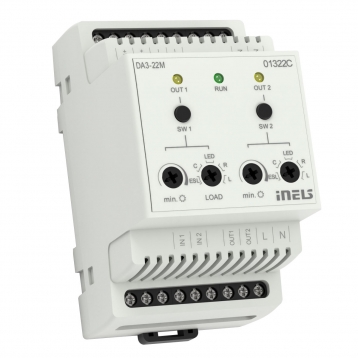
Key Features
DA3-22M is a universal dimming 2-fold actuator.
Dimming Control: Enables control of brightness intensity for dimmable light sources such as ESL, LED, and RLC with a power supply of 230 V.
Dual Output Configuration: Equipped with two MOSFET-controlled outputs at 230 V AC. Maximum load capacity: 2x 400 VA.
External Temperature Sensor: Option to connect an external temperature sensor for enhanced functionality.
Independent Control: Each output channel is independently controllable and addressable.
Light Source Selection: Type of light source can be set using a switch on the front panel.
Min. Brightness Adjustment: Minimizes flashing of different light sources by adjusting the minimum brightness potentiometer on the front panel.
Input Control: Equipped with two inputs at 230 V AC, controllable by mechanical switches (buttons, relays). Inputs are galvanically connected to potential L, permanently available at terminals IN1 and IN2.
Manual Control: Allows manual switching on or off of corresponding outputs using buttons on the front panel.
Electronic Protection: Features electronic overcurrent and thermal protection mechanism. Automatically switches off output in case of overload, short circuit, or overheating.
Power Supply Protection: Requires protective element for the power supply (potential L) corresponding to the power input of the connected load (e.g., safety fuse).
Installation Guidelines: Recommended to leave at least half the module space on each side of the actuator during installation for improved cooling.
Modular Design: DA3-22M 3-MODULE version designed for mounting into a switchboard on DIN rail EN60715, ensuring compatibility with standard installations.
Exemplary circuit diagram/ Wiring Diagram
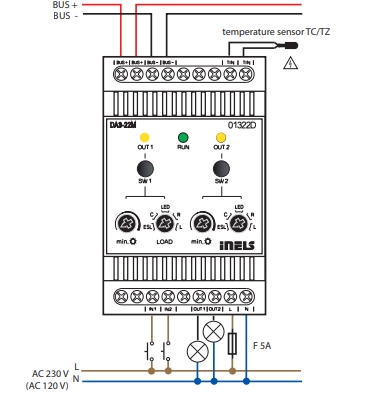
Compatibility chart ( CU, minimal FW version and Integration)
1
CU3-01M
01.36.00
NA
NA
2
CU3-02M
01.36.00
NA
NA
3
CU3-07M
01.36.00
Yes
Yes
4
CU3-08M
01.36.00
Yes
Yes
6
CU3-09M
Preparation
Preparation
Preparation
7
CU3-10M
Preparation
Preparation
Preparation
Programming in iDM
Introduction
iNELS Design Manager, or IDM3, is for programming iNELS units. This software serves as the platform for configuring device parameters, defining functions, and executing the programming required for iNELS units.
Device parameters, such as sensor range and thresholds, backlights, and operational modes, can be easily adjusted within the IDM3.
The process of programming in IDM3 typically involves defining functions and establishing logical connections between different devices. This allows for the creation of automation scenarios and the implementation of intelligent control strategies.
Starting up
Select the "blue control icon" as shown in Fig 1 > Clicking on the option "New project from default template“ allows you to create a new project from a predefined template.
Select the "Device manager" (Fig 1)> Add "New unit "> Select the central unit > Add "New unit">Select the "Internal-Master/ BUS"> Add "New unit "> Add the devices> Click on the devices to see the "Parameters".

Parameters:
Parameters in the iNELS devices refer to the measurable factors or characteristics that define the behavior or performance of the device. These could include electrical properties, physical dimensions, environmental conditions, and various other specifications depending on the type of device.
These are settings specific to individual devices within your automation system. The specific parameters of the DA3-22M in the iDM as shown in Fig.2.

Clicking on the DA3-22M (Fig.2), will navigate to the selected firmware, unit address, name, and description, along with other parameters as described below :
It is important to add the device address for proper communication with the unit. The Hexadecimal device address can be find from the device.
SW1, SW2: A "switch" could refer to a virtual or physical switch that controls a specific function within the DA3-22M. For example, you might have switches to control lights, heating, or other smart devices in your installation. These switches can be programmed and configured within the iNELS Design Manager to customize the behaviour of your system.
IN1 and IN2: These parameters refer to the input terminals of the DA3-22M actuator. IN1 and IN2 are connected to mechanical switches (buttons, relays) for external control. Inputs are galvanically connected to potential L, which is consistently available at terminals IN1 and IN2.

Invert Input: Invert Input parameter determines whether the input signal received from IN1 and IN2 should be inverted before processing. When enabled, the actuator interprets the input signal inversely, resulting in reversed behavior compared to the default configuration.
Split strictly long/short press in IN1 and IN2: This parameter configures how the actuator distinguishes between short and long button presses on IN1 and IN2. When enabled, the actuator can differentiate between short and long button presses with strict separation, allowing for more precise control options.
OVT-ALERT (Overtemperature Alert): The term "OVT ALERT " in the context of a dimming actuator refers to an Overtemperature Alert associated with the each output channel of the dimming actuator. The Over temperature Alert is designed to notify users or the system administrator that the temperature of the dimming actuator, from each Output, has exceeded a predefined threshold.
OVLO-ALERT (Over load Alert): The term "OVLO ALERT " in the context of a dimming actuator refers to an Overload Alert associated with the each output channel of the dimming actuator. The Over load Alert is designed to notify users or the system administrator that the load of the dimming actuator, from each Output, has exceeded the limit. (Overload: Excessive current flow beyond the rated capacity)
OUT1 and OUT2: OUT1 and OUT2 are the output terminals of the DA3-22M actuator. These terminals control the dimming of connected light sources, with each output channel independently controllable and addressable.

Use Default State: In the context of a switching actuator, the term "default state" pertains to the pre-established or initial condition that the actuator adopts in the absence of communication from the bus or central unit. Enabling this function ensures that the relay automatically assumes its default state, which is set to OFF
Default Output State: Upon choosing the "use default state" option, you will be prompted to specify the default output state. This refers to the pre-established or initial condition that the actuator adopts when there is no communication from the bus stop or central unit. Upon selecting this function, the relay will transition to its default output state, which, in this case, is set to ON.
Use Min and Max Limit: This parameter enables the utilization of minimum and maximum limits for outputs OUT1 and OUT2. When enabled, the actuator adheres to predefined minimum and maximum intensity levels for dimming control.
Minimum Level and Maximum Level : Defines the minimum and maximum intensity levels for outputs OUT1 and OUT2, respectively. These parameters establish the range within which dimming operations are constrained, ensuring optimal control and performance.
TIN (External Temperature Sensor Input): TIN refers to the input terminal for connecting an external temperature sensor to the DA3-22M actuator. This input allows the actuator to monitor external temperature conditions, enhancing its functionality.

Sensor Type: Sensor Type parameter specifies the type of temperature sensor connected to TIN. There are two types of sensors such TC and TZ. It ensures compatibility and proper calibration with the temperature sensor used.

Offset Temperature: Offset Temperature parameter allows for calibration adjustments to compensate for any temperature measurement discrepancies. It ensures accurate temperature readings by fine-tuning the sensor's output.
Minimal Temperature: Minimal Temperature parameter sets the lower limit for acceptable temperature readings from the connected sensor. It defines the minimum temperature threshold that triggers sensor responses or actions.
Maximal Temperature: Maximal Temperature parameter sets the upper limit for acceptable temperature readings from the connected sensor. It establishes the maximum temperature threshold that triggers sensor responses or actions.
Average time: Defines the time period over which multiple temperature readings are averaged to obtain a stable and accurate measurement.
Exports for iNELS Cloud and APP
Setting Up Control and Monitoring for iNELS Cloud and iNELS App
It is possible to control and monitor all the bus units in iNELS cloud and iNELS app. There are two stages to set up this function. Stage one is to do configuration in iDM3 and stage 2 is to do Configuration in iNELS cloud page and iNELS app.
Configuration in iDM3.
1. Unit and Parameter Selection:
Begin by accessing the iDM3 interface on your PC connected to CU. Navigate to the Device Manager section and carefully select the units and parameters you wish to control. This step is essential for determining what gets exported to the iNELS cloud and app.

2. CU Configuration and Third-Party Settings :
After the above step, go to the CU configuration in the iDM3, and select the page for third-party settings.
Inside the third-party settings page, designate the port for cloud connection. Set the mode of operation and choose the numerical system as hexadecimal. Pay close attention to verifying and configuring all essential parameters for successful cloud export.
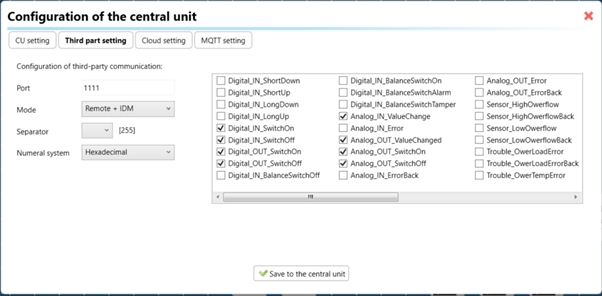
3. Cloud Settings:
Move on to the Cloud Settings section within iDM3.
Input the details of your iNELS cloud account. If you haven't created one, utilize the "New User" tab on the iNELS Cloud web page to establish a free account. (Inels Cloud - ElkoEP).
Select the mode and input the cloud account credentials. Save the project to the central unit to generate and store the export project file in the iNELS cloud account.
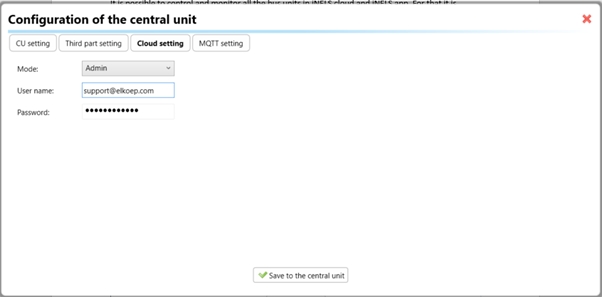
Configuration in iNELS cloud page and iNELS App.
1. Online Status Verification:
Once the cloud credentials and export settings in iDM3 are configured successfully, check the iNELS cloud account's Gateway section. Confirm that the Central Unit (CU) is online and that the export file has been automatically sent to the cloud under your account.

2. Device Creation in Cloud Platform:
In the cloud platform, you have to create new devices in order to control it remotely.
In the device tab, you will find the add device button, which can be used to associate export elements from IDM with the required types and icons.

After entering any name of the device, you select the icon, the MAC address of the communication gateway (in this case CU3), a specific type of device and the address of a specific function and element from the iNELS BUS system.
In order to be able to use the iNELS application to control the devices from CU over the local network or the cloud, it is necessary to create a room for bus devices for each central unit and add the devices into the room.
Follow these steps meticulously to ensure a seamless configuration process for controlling and monitoring all bus units through iNELS cloud and iNELS app.
3rd Party Integration with iNELS BUS
3rd Party Integration (MQTT)
iNELS units support MQTT integration on central units CU3-07M, CU3-08M, CU3-09M, and CU3-10M. It is necessary to select the devices and parameters for 3rd party integration on the device manager in the iDM.
Please note that you have an MQTT broker (local or cloud) running in the installation for this integration.
After you have a working MQTT broker you need to configure iNELS Central units to communicate with it. If you have no knowledge of what MQTT is, you can learn about it from MQTT Essentials articles. https://www.hivemq.com/mqtt/
There is a pre-installed MQTT broker in the iNLES bridge, it can be used to connect the iNELS Central units for integration in your projects.
Configuration in iDM3: Select units of 3rd Party integration.
Unit and Parameter Selection:
Begin by accessing the iDM3 interface on your PC connected to CU. Navigate to the Device Manager section and carefully select the units and parameters you wish to control. This step is essential for determining what gets exported to the 3rd party integration via MQTT.

2. CU Configuration and Third-Party Settings :
After the above step, go to the CU configuration in the iDM3, and select the page for third party settings.
Inside the third-party settings page, designate the port for third-party connection. Set the mode of operation and choose the numerical system as hexadecimal. Pay close attention to verifying and configuring all essential parameters for successful third-party integration.

3. MQTT Settings:
Move on to the MQTT Settings section within iDM3.
Input the details of your MQTT broker.
Select the mode and input the broker credentials such as IP, port username and password. Save the project to the central unit.
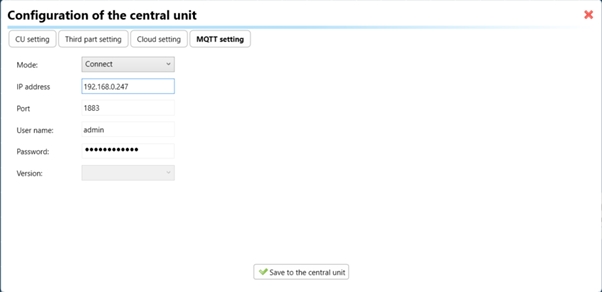
MQTT payload
For MQTT payload description please refer the link below. https://wiki.inels.com/v/inels-bus/3rd-party-integration/mqtt-payload-description-of-inels-bus-devices
Appendices
Last updated